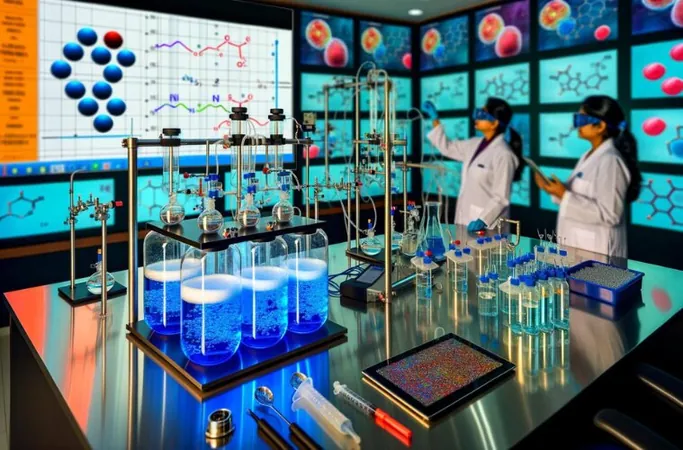
Revolutionary Breakthroughs in Acidic CO2 Reduction: The Future of Sustainable Fuels!
2025-01-06
Author: Olivia
In a world increasingly threatened by climate change, the demand for sustainable and efficient methods to convert carbon dioxide (CO2) into usable chemicals and fuels is more critical than ever. As industries face the dual challenges of cutting carbon emissions while transitioning to renewable energy sources, electrocatalytic CO2 reduction emerges as a beacon of hope. Unlike traditional methods conducted in alkaline or neutral environments—which often stifle carbon efficiency—acidic conditions unveil remarkable advantages.
Unlocking the Power of Acidic Environments
Acidic electrocatalytic CO2 reduction not only enhances carbon efficiency but also minimizes the unwanted production of (bi)carbonate, a significant byproduct that hampers CO2 utilization in alkaline systems. This shift to acidic conditions not only boosts operational efficiency but also stabilizes processes, making it a game-changing alternative for industrial applications. By harnessing renewable electricity, researchers envision a future where CO2 can be converted into a dazzling array of products, from basic hydrocarbons to complex multi-carbon chemicals.
Navigating the Hurdles of Acidic CO2 Reduction
Despite the promising prospects, the acidic CO2 reduction reaction (CO2RR) faces notable challenges. The primary obstacle is the enhanced hydrogen evolution reaction (HER), which competes with CO2RR and can significantly diminish the selectivity of desired products. Additionally, the corrosive nature of acidic environments raises concerns regarding the durability of electrocatalysts and the reliability of the entire reaction apparatus.
Innovators in the field are actively developing specialized catalysts designed to selectively reduce CO2 while stifling HER. Fostering this selective environment involves a careful tuning of the catalysts’ electronic structures to enhance CO2 interactions. The implementation of proton exchange membranes (PEM) is also revolutionizing the scene by improving proton conductivity and stability—two essential components for maintaining effectiveness in this transformative process.
The Catalytic Innovation Revolution
At the core of CO2 reduction lies advanced electrocatalysts. Scientists are making strides in their design to maximize the potential of acidic CO2RR. For example, bimetallic catalysts have emerged as promising candidates, creating optimal conditions for CO2 adsorption while curbing hydrogen production.
Tailoring the surface chemistry of these catalysts can generate microenvironments that stabilize crucial reaction intermediates, significantly optimizing overall efficiency. Incorporating functional ligands allows for enhanced control over reaction dynamics. These innovations are vital in overcoming the inherent challenges of acidic media, setting the stage for groundbreaking technologies in CO2 conversion.
Next-Gen Electrode and Electrolyte Innovations
In tandem with advancements in catalysts, innovative electrode designs and electrolyte compositions are propelling acidic CO2 reduction forward. The introduction of gas diffusion electrodes (GDE) integrated with membrane electrode assemblies (MEA) marks a significant leap. These configurations not only enhance mass transfer but also drastically reduce resistance, amplifying the efficiency of CO2 conversion.
Additionally, the selection of electrolytes is crucial for success. Recent studies indicate that integrating larger cations into acidic electrolytes can effectively limit proton migration, thereby enhancing CO2RR efficiency and selectivity. Such breakthroughs underscore the importance of both electrode and electrolyte design in realizing practical and scalable applications for acidic CO2RR.
Industrial Implications and Bold Prospects Ahead
The promise of acidic CO2RR transcends laboratory settings, presenting a viable route for large-scale CO2 conversion. Industries striving to lessen their carbon footprints are increasingly drawn to technologies capable of transforming waste CO2 into valuable products. However, the journey from research to real-life applications is fraught with technical and economic barriers.
Future endeavors must focus on boosting catalyst durability in acidic conditions and optimizing scalable electrolysis equipment. Enhancing reactor designs to optimize single-pass CO2 conversion efficiency will be vital for practical implementation. Meeting these challenges could position acidic CO2 reduction as a cornerstone of sustainable industrial practices.
A Sustainable Future in Sight!
The ultimate ambition of CO2 reduction technologies is to harmonize efficiency and sustainability. Acidic electrocatalytic CO2 reduction stands out as a vehicle to this equilibrium, promising to convert greenhouse gases into economically viable products powered by renewable energy. As research evolves, the integration of acidic CO2RR into broader industrial frameworks could play a pivotal part in global climate change mitigation efforts.
By fostering collaboration among researchers, industry professionals, and policymakers, the horizon for CO2 reduction technologies appears bright. With focused initiatives, acidic electrocatalytic CO2 reduction may soon become an essential component in the pursuit of a sustainable, carbon-neutral future, perfectly aligned with global environmental and energy innovation goals.
Could this innovative technology be the key to saving our planet from climate catastrophe? Only time will tell!



 Brasil (PT)
Brasil (PT)
 Canada (EN)
Canada (EN)
 Chile (ES)
Chile (ES)
 Česko (CS)
Česko (CS)
 대한민국 (KO)
대한민국 (KO)
 España (ES)
España (ES)
 France (FR)
France (FR)
 Hong Kong (EN)
Hong Kong (EN)
 Italia (IT)
Italia (IT)
 日本 (JA)
日本 (JA)
 Magyarország (HU)
Magyarország (HU)
 Norge (NO)
Norge (NO)
 Polska (PL)
Polska (PL)
 Schweiz (DE)
Schweiz (DE)
 Singapore (EN)
Singapore (EN)
 Sverige (SV)
Sverige (SV)
 Suomi (FI)
Suomi (FI)
 Türkiye (TR)
Türkiye (TR)
 الإمارات العربية المتحدة (AR)
الإمارات العربية المتحدة (AR)